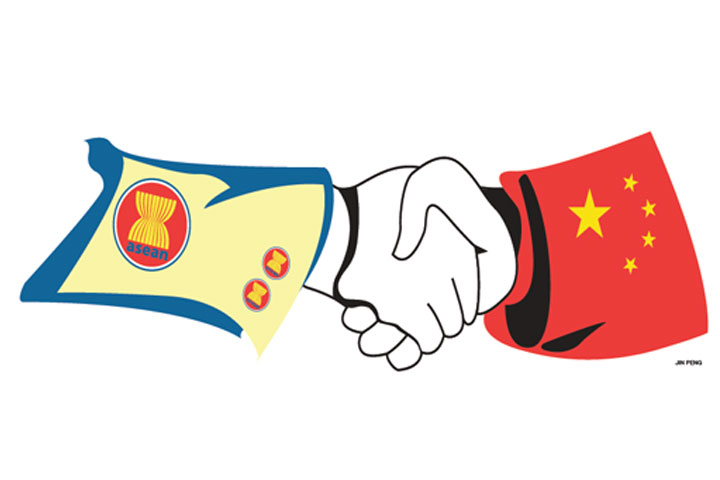
After the relaxing of the strict COVID-19 policies, Southeast Asian countries gradually brought their economic and social activities back on track in 2022. The pandemic-induced economic downturn is easing, corporate bankruptcies and social instability have abated, and Southeast Asian economies have in general regained their pre-COVID scale.
Among the 10 Southeast Asian countries, Vietnam, Malaysia, the Philippines and Indonesia have demonstrated the most remarkable economic performance. According to the Asian Development Outlook released by the Asian Development Bank, the 2022 GDP growth forecast is 7.5 percent for Vietnam, 7.3 percent for Malaysia, 7.4 percent for the Philippines, 3.2 percent for Thailand, 5.4 percent for Indonesia and 3.3 percent for Singapore. The Southeast Asian economy as a whole is forecast to grow by 5.5 percent in 2022, almost on par with the pre-pandemic growth rate. Such remarkable growth looks very impressive in a world where the major economies are still mired in the adverse impacts of the pandemic.
However, whether such growth rates can be sustained depends on the overall world economic environment, in particular that of the Southeast Asian countries' major economic and trading partners including China, the United States, the European Union and Japan.
In 2022, the China-US strategic competition was locked in a stalemate and the Russia-Ukraine conflict broke out. Against such a backdrop, the US and European countries have been coercing and pressuring the Association of Southeast Asian Nations and regional countries into submitting to their will and approach against Russia and China — on the one hand following the US steps in isolating and containing China, and on the other hand following the US and European steps in condemning and imposing sanctions on Russia.
In May 2022, the US launched the "Indo-Pacific Economic Framework for Prosperity" in Tokyo. Seven out of the 10 ASEAN countries — Brunei, the Philippines, Indonesia, Malaysia, Singapore, Vietnam and Thailand — are among the 13 initial members of the new group set up by the US, while the remaining three ASEAN members — Cambodia, Laos and Myanmar — were not invited because of so-called democratic issues or for being too close to China.
In mid-May 2022, prior to the launch of the IPEF, the Joe Biden administration invited the leaders of ASEAN countries to attend the US-ASEAN Special Summit in Washington to commemorate the 45th anniversary of bilateral relations. During the summit, President Biden, US Secretary of State Antony Blinken and other officials took it in turns to tout the IPEF proposal in an attempt to rope in ASEAN countries to isolate China and decouple from China, with regard to both the economy and technology, but to no avail. Clearly, countries wish to benefit from the IPEF but do not want to confront China.
On the issue of the Russia-Ukraine conflict, the US and the EU explicitly demanded that ASEAN countries join the Western camp, including openly condemning Russia, imposing sanctions on Russia, and excluding Russia from the G20 Summit held in Bali, the East Asia Summit held in Phnom Penh and the APEC Summit held in Bangkok. In the face of US pressure, some ASEAN countries such as Vietnam abstained from the United Nations vote condemning Russia's special military operation in Ukraine, and Indonesia, Cambodia and Thailand resisted US pressure to exclude Russia from the G20 Summit, East Asia Summit and APEC Leader's Meeting and explicitly said that they would not pick sides on the issue of the Russia-Ukraine conflict. Their choice demonstrates that no country wishes to see Southeast Asia become an arena for geopolitical competition between the world's major powers.
As neighbors, China and the Southeast Asian countries have maintained close political, economic, trade and cultural exchanges. China remained ASEAN's largest trading partner for 13 consecutive years from 2009 to 2021, and ASEAN has been China's largest trading partner since 2020. Despite the negative impacts of the COVID-19 pandemic and geopolitical turbulence, economic cooperation and trade ties between China and ASEAN have maintained robust growth momentum against the headwinds.
China unswervingly makes ASEAN a high priority in its neighborhood diplomacy, supporting ASEAN in playing a bigger role in regional and international affairs, and opposing the frequent pressuring of countries in international relations.
With mutual respect and constantly deepening mutually beneficial cooperation, China and the Southeast Asian countries have set a stellar example for relations between developing countries for the international community.
China and all Southeast Asian countries have maintained close exchanges even though the pandemic has yet to end. Practical cooperation between the two sides has maintained strong growth momentum. China and Laos have made remarkable progress in railway construction and climate action cooperation; China and Thailand have made marked progress in industrial park construction and railway locomotive manufacturing cooperation; China-Cambodia cooperation on the expressway that stretches between Phnom Penh and the port city of Sihanoukville has received wide acclaim from the Cambodian government; China-Vietnam cooperation in the digital economy and e-commerce has yielded fruitful outcomes.
Despite the external interference of Western powers outside the region, led by the US, that are constantly making provocative moves and stoking confrontations in the South China Sea, China and the ASEAN countries are speeding up negotiations on a Code of Conduct for the South China Sea. China is promoting relations with regional countries on the basis of mutual respect, setting an example of friendly relations between countries of different sizes. Regional countries are seeking to achieve a balance in their interactions with the world's major powers.
Source: China Daily
Share: